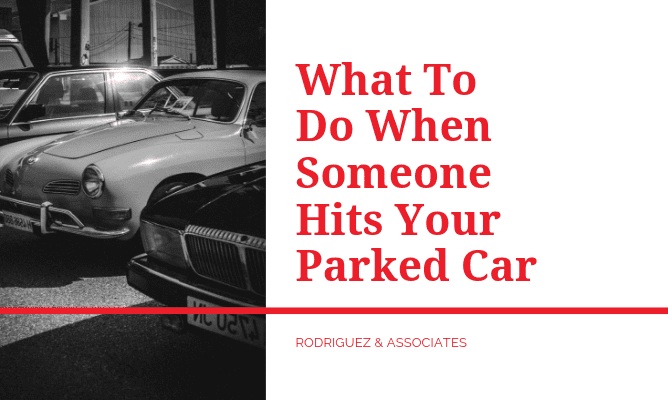
Many low-speed, low-value auto accidents happen in parking lots and garages, and any parked vehicle on the street is potentially susceptible to damage from passing negligent motorists. If another driver hits your parked car, you should know what to expect from the situation. In the event you happen to be in or around your parked car when another driver hits it, you should have the opportunity to take down the at-fault driver’s contact information and insurance details so you can file a claim.
Unfortunately, Allstate Insurance reports that about 70% of all hit-and-run accidents involve parked vehicles, so the owner of a parked vehicle that sustains damage from a hit-and-run may not know what to do about recovery.
When You Witness the Accident
If you happen to be in the area and see the accident with your parked car, or if the at-fault driver takes responsibility and waits for you at your car after the collision, follow the same procedure you would with any other car accident. Take the at-fault driver’s contact information and insurance details, try to take photos of the damage to your vehicle and the surrounding area, and make sure your vehicle is fit to drive before leaving the scene. You should also contact the police so there is a record of the incident, but only if the accident resulted in damage beyond a minor ding or dented bumper. Most states require drivers to report any accident that results in injury, death, or significant property damage.
After obtaining the necessary information from the accident scene, file a claim according to your state’s laws for car accidents. In a fault-based state, an injured driver files a claim against the at-fault driver’s insurance policy, and the insurance carrier pays for damages up to the coverage limits of the policy. If the at-fault driver is operating a public transportation vehicle, our bus accident attorneys in Bakersfield can help.
In a no-fault state, an injured driver’s first step toward recovery is to file a claim against his or her own auto insurance policy for personal injury protection coverage. The photos from the accident scene and the proof of the other driver’s liability will be invaluable to any insurance claim.
When the At-Fault Driver Leaves the Scene
When a driver hits a parked car, the legal and ethical thing to do is to remain at the scene until the owner of the parked vehicle arrives so the drivers can exchange information and document the incident. The responsible driver may opt to leave a note with his or her information on the damaged vehicle’s windshield, and this is acceptable in most situations.
However, some drivers may simply flee out of panic or to avoid liability. In these situations, it can be very difficult to track down the responsible driver. However, if the police locate the hit-and-run driver, he or she will face criminal charges from the state in addition to civil liability for your accident.
If you return to your vehicle to find another driver has hit it but failed to leave his or her insurance information, you should contact the police to report the hit-and-run. The police may have access to traffic cameras to help identify the responsible driver. If the accident occurred in a busy area near businesses, those establishments may have CCTV footage outside their stores that may help prove liability. It is vital to report the hit-and-run to the police as soon as possible so they can begin an investigation.
When it comes to recovery for a hit-and-run, you may need to rely on the police to identify and apprehend the at-fault driver to hold him or her responsible for your damages. Depending on the terms of your auto insurance coverage, your insurer may provide coverage in the interim. If you identify the at-fault driver, your insurer will likely seek reimbursement for coverage for the accident by negotiating with the at-fault driver’s insurance carrier or taking legal action against the at-fault driver.